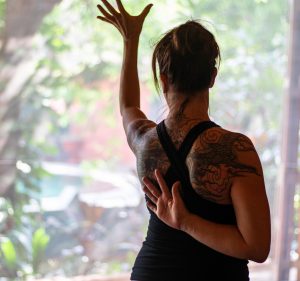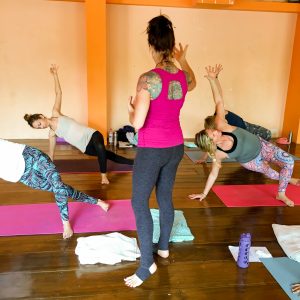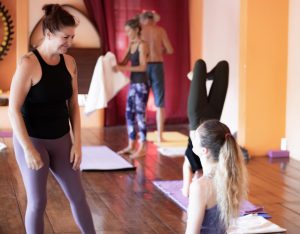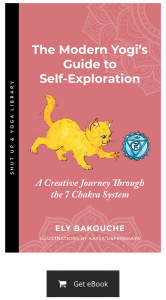I’m sitting in the back of an Uber. I often find myself sitting in the back of an Uber in different cities around the world. I’m usually on my way to an airport or train station headed to another city to teach another workshop. The driver and I start with the usual: “Where are you headed?” Me: “I’m on my way to Stockholm, Zurich, et cetera.” Driver: “Oh, do you spend a lot of time travelling?” Me: “Yes, I travel a lot for work.” Driver: “Well, that must be hard spending so much time away from home.” Me: “Yes, but I love my job. I’m passionate about what I do.” I start to squirm a little bit in my seat because I know the next question is coming. It’s inevitable. And I know I’m about to tell another little white lie. Here it comes. Driver: “So what do you do?” Me: “I’m a movement therapist. I study neuroscience and the response in the body and the nervous system and fascial network, and use movement and breathwork to help people overcome stress, trauma, and daily dysfunction to find a sense of grounding and well being.”
Yes, that’s right, I don’t tell people I’m a yoga teacher. Why not?
The truth is, I’m embarrassed by the perception of being a yoga teacher in this digital age.
Twenty-five years ago, when I first started teaching, yoga was still a mystery to the masses. Anyone who taught yoga had a deep respect for other teachers because we were all out on a limb, set apart from the mainstream. It was a given that if you were teaching, you’d put in a lot of time and energy, self-study, and endless hours of practice to be able to stand in front of a group and share your knowledge.
But now, yoga is so mainstream it’s hard to find somebody who hasn’t at least tried a class. And, just like what they say about being no more than 20 feet from a rat in any major city, it’s likely you’re the same distance from someone who has done a 200-hour yoga teacher training and is teaching yoga.

I decided to do a little research into other, somewhat related fields to see the comparison. Below are the minimum requirements to receive licensing or accreditation in various wellness professions, based on US regulations:
Physiotherapist, Sports & Rehabilitation: Bachelor’s degree plus 2–3 years of specialist training in Physical Therapy, plus accreditation.
Naturopath: 4 years of graduate-level study to become licensed.
Homeopath: 3–4 years of full-time study at an accredited school.
Ayurvedic medicine: 4 years of pre-med plus 1–2 years at an Ayurvedic college, followed by an exam to gain licensure.
Massage Therapist: Varies by state, but the average is 1,000 hours of training and practice plus an exam to obtain licensure.
Certified Fitness Instructor (This came the closest to the requirements for yoga training): Depending on the state and if you also want to become a personal trainer, courses start from 100 hours over two months to 500 hours over six months. You do not need a licence; however, most fitness centers and gyms only hire certified instructors.
Hairdresser: Minimum of 1,000 hours over one year and usually extra unpaid experience, and then you must pass two exams with the licensing board.
Of all those professions, would you trust anyone “practicing” that had only 200 hours of training? So why do we think it’s ok in the yoga industry?
Think about it. Only 200 hours to understand the principles and anatomical implications of the asanas, to understand the nervous system and how the breath and pranayama affect the body and the mind.
To understand the common injuries that occur through yoga practice, plus the ones that students arrive with, like chronic back pain. To understand the history of Yoga, the lineages, and their development over the last 2,000 years. To understand the philosophy behind these lineages well enough to repeat them to your students. To understand the implications of emotional and mental states that may arise in the classroom and how to deal with them. To understand how to stand up in front of a group of people and guide them through all of the above, often in under 90 minutes. To understand how to create a well-structured class that can accommodate beginners or people with different ranges of mobility. To understand how to be a self-employed, often underpaid and under-valued, web-designing, social media genius, and maintain your commitment to your own practice at the same time. 200 hours, the minimum set by Yoga Alliance.

Why was the bar set so low?
The 200-hour minimum was set by a small handful of people in 1999 before Yoga Alliance fully formed. Specifically, the number was set after Dean Ornish, MD, released a peer-reviewed study showing that yoga and meditation greatly helped in reversing heart disease. It was primarily meant to set a standard for medical clinics wanting to add yoga to their skill set. So it was meant to be a minimum requirement as an add-on for medical professionals who would have already had years of training in understanding the human body. And by the way, it is important to note that Yoga Alliance is not, and has never been, a licensing, accrediting, certifying, regulatory, or governing body of yoga. They are a registry, that’s it—kind of like TripAdvisor for yoga teachers and schools.
I get why so many studios run teacher trainings: In most places, rents are high, classes are priced competitively, and teacher trainings add essential extra income. But because studios are often highly focused on that extra income, there is little thought or attention on what might be the long-term effect of holding two or more trainings every year.

The biggest problem in the watering down of yoga is that my Uncle Bob (seriously, I do have an Uncle Bob) who has never done yoga in his life could walk in off the street, pay a deposit, get signed up, train and then receive a certificate, sometimes in under a month, no questions asked. This is abhorrent. And it is not okay.
I come across hundreds of teachers who complain that their first or even second Level One training was a waste of time and money because the leaders of the course had to go back to the extreme basics given the number of complete beginners attending—encouraged by the studios to be there, of course. Another common complaint is that there were too many students in the course, so the teachers didn’t even have time to get to know people individually. Sometimes, 30-40 people attended the training, to be completed in under a month, with over half there to “just get a deeper understanding of yoga.” Pardon my French, but WTF.
In my opinion, a teacher training is not the place to gain a deeper understanding of yoga. If that’s what you want, join a foundation course or a basics immersion. And studios: it’s a shame that you don’t hold more of these. Foundation and immersion courses for students who want to learn more about any subject are the underpinnings of most educational systems. Creating courses for the layperson will not only increase your connection to your student base but also generate more income. And you can put as many people as you like in a foundation course. You don’t need to go in depth into anatomy, no sequencing, no language skills, no adjustment information, no code of ethics or setting boundaries. Just yoga, the practices, the history and lineages. I propose this model to every studio I travel to and teach in, and the studios that implement these kinds of courses always tell me they are very successful.
I sometimes hear teachers say, “But everyone wants a certificate these days.” Really? A market driven by what the client wants is called retail. Yoga shouldn’t be sold as a commodity (I know it’s a bit late), but most importantly, teaching yoga should definitely not be sold as a commodity. Teaching yoga should be a vocation that evokes pride in the practice and in the endeavours each teacher has undertaken to be fully prepared, to know that they are in service, and not to be taken lightly.

Back in 2005, when I decided to run my first teacher training and Yoga Alliance was still relatively new, I looked at the 200-hour minimum as just that, a minimum. I set all my Level One courses at 500 hours and 10 weeks, 6 days a week. A full-time training. Maximum of 12 students. I then set the Level Two at 350 hours. A total of 850 hours of training. I thought to myself, “Ok, that should be a good start.” In those early years of the yoga boom, training was much more highly respected. The original Yoga Works’ TTC was 3 years, and not everyone passed the final exam. Say what you like about John Friend, but for Anusara training, you needed to do two 100-hour immersions before joining their multi-tiered training programme.
Nowadays, the primary demographic for my teaching is other teachers: those who have completed a 200-hour, entry-level training and realize they need more information to become good teachers or to push themselves beyond mediocre. And thanks to the number of 200-hour teacher trainings cropping up under every rock, my demographic is huge and worldwide.
I left Yoga Alliance over 2 years ago, as a school and teacher, and it hasn’t hurt my business at all—in fact, it’s helped my bank account a lot. I couldn’t bring myself to continue to give money to an organization that set the bar so low when I was striving to set it higher.

If you’re like me and are worried about the state of yoga, the high amount of competition, and the dire payment structure for teachers, then help stop the perpetuation of low-standard yoga teacher trainings.
Tell the studios you work for to raise their standards for qualifying teachers. If you run a studio, raise your own standards. No one is bound to any organization in yoga. You are only bound to your own conscience and how you want to be perceived as a provider of trainings. What kind of quality to do you want associated with your brand name?
I love what I do. As I pass the 25-year mark as a teacher, I find that I’m passionate about empowering and inspiring teachers and helping them to gain as much knowledge as I can pass on. There is value to what I do, and I deeply respect others who endeavour to raise the bar continually. And one day, when we’ve put quality above quantity, and integrity above money in yoga, hopefully, I’ll be proud to again call myself a yoga teacher.
Edited by Jaimee Hoefert





